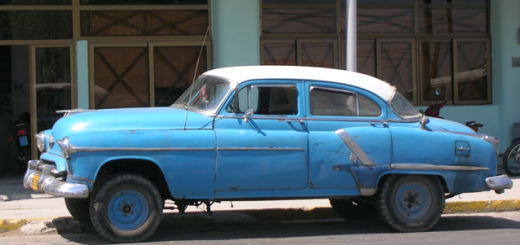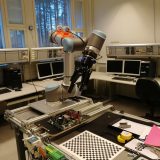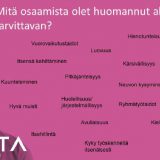Learning about different operating environments and good practices
In the School of Natural Resources at Oulu UAS the course International Operating Environment is offered in English for incoming exchange students. The aim of the course is that students familiarize themselves with a chosen sector in the field of natural resources and compare the Finnish operating environment with that of their home country. Also the students are expected to find good practices they see worth transferring from one country to another.
In autumn term 2016 there were four exchange students who chose this course in their study programme. During the course they gathered information from Finnish farms and other enterprises, talked to experts in the field and studied published materials. At the end of the course they compiled a written report on their findings and gave a presentation.
From left to right Kristyna Dyntarova, Tamás Banyai, Jiři Zhor, Katarzyna Tokarz
Tamás Banyai compared the feeding systems and fodder preparation of dairy cows on Finnish and Hungarian farms. Among other information sources he spoke to an expert in Finnish fodder company and visited dairy farms and interviewed the farmers.
Total mixed ration (TMR) is the practice of weighing and blending all feedstuffs into a complete ration which provides adequate nourishment to meet all the needs of dairy cows. Hungarian dairy farms often use TMR, especially the bigger ones. However, only 20% of Finnish dairy farms use TMR. Partial mixed ration (PMR) is for only sustaining the cows and concentrate must be given according to cows’ other needs. In Hungary the main protein sources are soy and sunflower seed, in Finland it is rape seed. Finnish dairy farmers use more protein supplement than Hungarian ones in average.
The main difference between Hungarian and Finnish grain feeding is the species of grains. In Hungary the most frequently used grains are corn and wheat. Finnish dairy farmers fodder barley as the main starch source. There is also difference in grain conservation. In Hungary grain seeds are stored whole, cleared and dried with about 12-14% water content. With this moisture, microbes cannot start to digest them. They can keep good for months or years. In Finland crimping is the mode of conservation. Hungarian dairy farmers feed several types of fermented forage such as maize silage, sorghum silage, grass silage and alfalfa pre-wilted silage. The most commonly used is maize silage. In Finland it is grass silage. The favourite species of grass is timothy and Finnish farmers often grow it in monoculture.
Another significant difference is the mode of fermentation. Maize contains much more starch than timothy, the microbes can digest it easier, and the fermentation is more stable. In Finland the temperature is not high enough for smooth fermentation, so farmers have to use several chemicals to advance the process. They add short carbon chain acids and microbes to the raw matter before the fermentation. These chemicals and their producing technology is very developed in Finland.
Kristyna Dyntarova compared Finnish and Czech biodynamic farming. Besides studying published information sources, she visited a biodynamic farm near Tampere and made a questionnaire to Finnish and Czech biodynamic farmers and to university students who study organic farming.
There are more biodynamic farms in Finland than in the Czech Republic (in absolute numbers, but also with respect to the total population). Generally, there are no significant differences in the experience and opinions of Finnish and Czech biodynamic farmers towards biodynamic farming. Both farmers learn about biodynamics mostly from friends or from personal experience on a biodynamic farm, but Finns also mention books and school. Two thirds of Finnish farmers confirm that in Finland it is easy to find information about biodynamics, while in the Czech Republic it seems to be more problematic. In both countries the most important reason to start with biodynamics is the social aspect, but as biodynamic farming is holistic, it is hard to separate the reasons for starting biodynamic farming.
The main problem of biodynamics is converting from conventional/common organic farming, but Finnish also mention that it is hard to gain the favour of neighbourhood or to find young people interested in biodynamic farming. In both countries the most used form of promotion is through personal contacts, but also websites, Facebook pages and summer markets are popular. Two thirds of Finnish farmers have no problem with selling their products, in the Czech Republic it is a bit worse.
In general, there are greater differences among students. The overall awareness about biodynamics is much bigger in Finland – 77.8 % of Finnish students versus 40.5 % Czech students have heard about it. They both know it mostly from school, but Finnish also mention the internet or books. 57.1 % of Finnish students know the difference between biodynamic and common organic farming while in the Czech Republic it is only 29.4 % of students. What is relatively the same is the awareness about DEMETER brand. Both know it mostly from school, but in Finland also from shops. A big difference is in the awareness about Waldorf education – 66.7 % Finnish students versus 29.7 % Czech students. Finnish students know it mostly from friends or school while Czech students mostly from internet or friends. In Finland all respondents would like to know more about biodynamics while in the Czech Republic “only” 91.9 %.
Katarzyna Tokarz studied similarities and differences between Polish and Finnish biogas plants and their management.
The number of existing biogas plants in Finland is lower than in Poland but that is not surprising. In Poland there are 40 million people and climate is easier to manage plants like this. Transport distance of heat and electricity is shorter than in Finland which is an encouragement to build and control biogas plants.
Costs for building and maintaining a plant are not very different. Also the permissions and regulations for building a plant are largely similar.
One difference is the substrates used. In Poland it is mostly agricultural waste, manure and corn silage and maize, as in Finland most biogas comes from landfills and slurry purifications. The reason for this is the big difference is waste management. In Finland waste treatment is well developed, especially bio-waste dispose. In Poland most of biogas plants use manure and grass but they could also be changed to use biodegradable waste. Biogas plant in Liszkowo is an exception but still it is not enough for the amount of waste produced in Poland.
As for biogas policy and law, in Finland it is easier for plants to share energy for municipal inhabitants. Polish law still require some changes about providing energy from private biogas plants. In both countries the governments encourage and support biogas production and use.
Jiři Zhor’s topic was the size and business of farms in Finland and in the Czech Republic
The trend in the European sphere is to increase the size of farms in order to make the farms more profitable on the trade. The speed of decreasing number of farms and increasing the size of farms is different everywhere and is mostly based on the economics of the country. Although the trend is the same in all the countries of the EU, circumstances influencing the farms´ sizes differ.
The average size of farms in Finland was 44 hectares in 2015. In the same time period, it was 133 hectares in the Czech Republic, which is the highest average in the whole EU. This is a big difference between the two countries that are both members in the European Union.
This situation is largely made by the happenings in the EU. Trade of each country bases on the trade in the EU and it influences the development of agricultural sphere and farms as well. A big impact was the abolition of milk production quotas, why the milk prices have gone rapidly down in whole Europe. Many farmers were forced to stop animal breeding and milk production and sell or rent the land to other farmers. One dissimilarity was in the economic situation. Before milk quotas abolition, the milk price in Finland was around 0.45 €, which was really extraordinarily high in the comparison with other countries of the EU.
From the point of view of the size of farms, we can´t forget the historical aspect. In the Czech Republic (originally Czechoslovakia) there was a communistic regime till 1990s, which has led to privatization of land. This had the biggest and also artificial impact on the development of farms. Big agricultural coops were formed which are the base for the big average size of farms.
One difference between the countries is the nationally funded support for farmers. Finnish agricultural system is better funded than the Czech agricultural system thanks to better financial and economical position of the country.
The ability to sell the commodities in the European trade is different for these countries. The location of the countries plays a role. The Czech Republic is situated in the middle of Europe and thanks to economically better situation of countries bordering with Czech Republic it is a really good starting point for the trade and business. Austria and Germany are really attractive and sought-after countries with well working trade, where Czech farmers can get more money than on domestic market. On the other side the Finnish trade is influenced by the position in northern Europe. First of all, the weather and environment is different than in other parts of Europe. The Farmers then don´t reach high quality of plant commodities, which is bad for potential sell. Position in Northern Europe gives to Finland little disadvantage, such as worse contact to mid-European trade. Transport is really expensive nowadays, so farmers rather sell commodities to purchasers around their farm. Really bad impact for Finnish economic, not only in agricultural sector was and still is the embargo with Russia. The Czech Republic is not that much dependent on the Russian trade as Finland.
Writers
Arja Maunumäki, senior lecturer, Oulu UAS
Tamás Banyai, student, Szent István University, Budapest, Hungary
Kristyna Dyntarova, student, Mendel University in Brno, Czech Republic
Katarzyna Tokarz, student, West Pomeranian University of Technology, Szczecin, Poland
Jiři Zhor, student, Mendel University in Brno, Czech Republic












